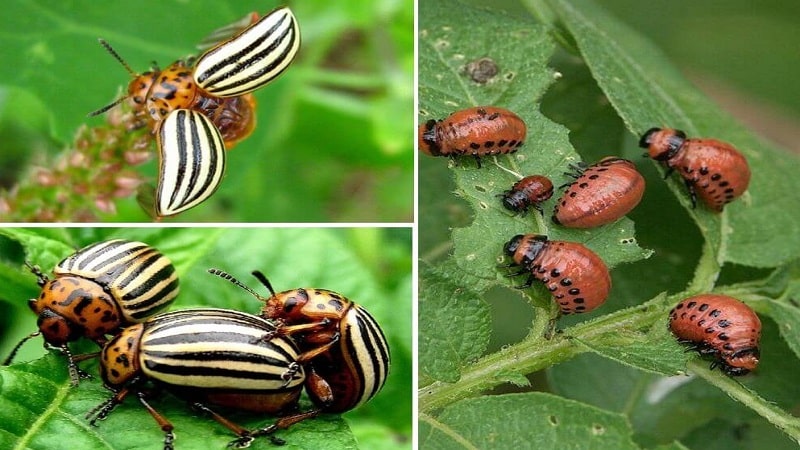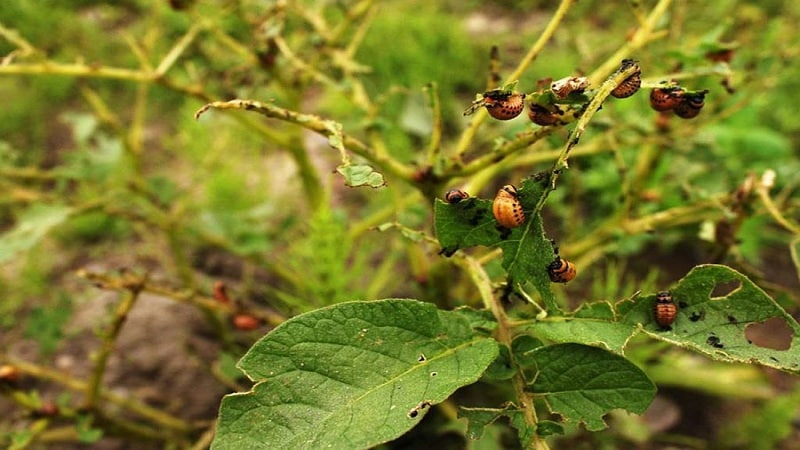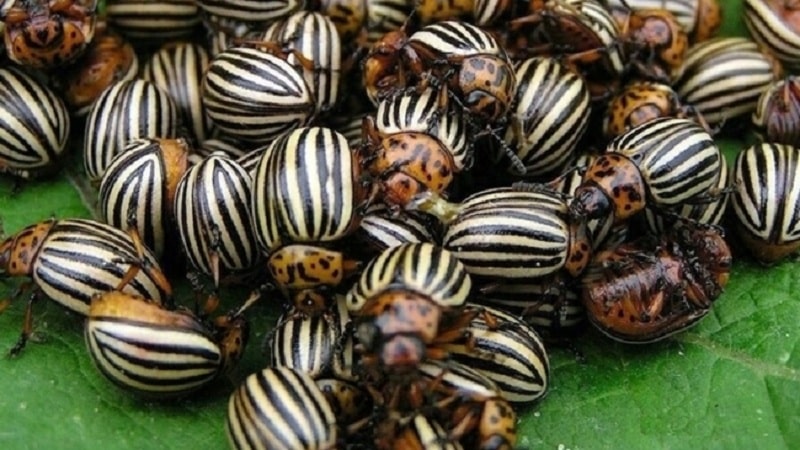How to escape from the Colorado potato beetle: how to treat potatoes
The Colorado potato beetle is a member of the leaf beetle family. It received its name in 1859 after it devastated a potato plantation in the US state of Colorado. Since then, his journey around the world began. In 1940, the beetle reached the western borders of the USSR. The pest is distinguished by its exorbitant appetite and ability to adapt to insecticides and herbal remedies.
We will tell you in this article how to treat potatoes against the Colorado potato beetle at each stage of the growing season.
Description and characteristics of the Colorado potato beetle
The Colorado potato beetle, or potato leaf beetle (lat. Leptinotarsa decemlineata), belongs to the family of leaf beetles. American entomologist Thomas Sayem discovered the insect in 1824. In 1865, the Swedish researcher Stahl included the beetle in the genus Leptinotarsa, to which it still belongs.
An adult Colorado potato beetle has a body length of 8-12 mm and a width of 6-7 mm. The body is oval, convex. The elytra are hard, glossy, yellow-orange with five black stripes on each. The wings are well developed, helping to fly long distances.
The length of the larva is 15–16 mm. The head is black, there are two rows of dark dots on the sides of the body. The color is first dark brown, then bright yellow or pinkish.

Life cycle
Only adult individuals leave for the winter, burrowing 20-50 cm into the ground. In the spring they rise to the surface and begin to reproduce. Females fertilized before hibernation actively lay orange eggs.During the day, the female lays 5-80 eggs, and over the entire summer - about 1000. The number of generations depends on the climate: in the north - 1, in the south - 2-3.
The larvae emerge from the eggs on days 5-17 and immediately begin to destroy the foliage. After 2-3 weeks they burrow 10 cm deep into the ground to pupate. The adult emerges after 10-20 days, depending on the weather.
The lifespan of beetles is 1-3 years. The insect can enter into a multi-year diapause, lasting 2-3 years. This allows him to survive in hungry years and at the same time makes it difficult to fight them.
Reference. In case of danger, the Colorado potato beetle does not fly away, but falls to the ground and pretends to be dead.
Nutrition
The main food of larvae and adults is juicy potato tops. Very rarely they are found on tubers in early spring. Hungry adults - adult beetles - attack potatoes only to restore strength before young shoots appear.
Harm of the Colorado potato beetle
The larvae are the most voracious. Despite the fact that one individual eats no more than 30 mg of plant tissue, mass distribution and the ability to quickly reproduce offspring leads to a loss of more than 40% of the harvest.
The most important process of plant metabolism—photosynthesis—occurs in foliage. As a result of the complex transformation of monosaccharides into polysaccharides, starch is formed. The formation of tubers and their taste depend on the quality of photosynthesis.
The peak activity of the Colorado potato beetle occurs during the flowering period, when the potato bush begins to put aside nutritional components in reserve. Damage to greenery leads to a delay in the formation of tubers and the penetration of fungi and viruses through wounds. The result is the loss of most of the crop without timely intervention.
The Colorado potato beetle is not dangerous to humans, but when it spreads en masse, it significantly complicates potato farming.
Signs of appearance

Signs of the appearance of the Colorado potato beetle on potato plantings:
- yellow-orange eggs on the back of leaves;
- dark spots on the foliage;
- leaf perforation;
- dry greens;
- larvae are bright yellow or pink;
- Striped beetles are round-oval in shape.
Reasons for appearance
Reasons for the appearance of beetles on the site:
- non-compliance with the rules of agricultural technology (crop rotation, weeding, tops harvesting);
- excess nitrogen in the soil;
- untimely start of treatment of bushes (recommended before landings and immediately after germination);
- use of ineffective drugs;
- development of pest resistance to chemicals and herbal infusions;
- the absence on the territory of our country of natural enemies of Colorados - the parasitic polyphage mite Piemotes tritici and the Perillus bug.
Potato varieties resistant to the Colorado potato beetle
There is no potato that is 100% resistant to the Colorado potato beetle, but the accumulated experience has allowed scientists to draw some conclusions:
- larvae and adults are less likely to damage plants with hard, hairy leaves;
- the unpleasant (from the insect's point of view) taste of the foliage repels the pest;
- the introduction of special genes that form a toxic protein makes it possible to repel the beetle.
List of relatively resistant varieties:
- Bryansk is reliable;
- Glow;
- Kamensky;
- Lasunok;
- Nikulinsky;
- The morning is early;
- Pace.
Transgenic varieties:
- Russet Burbank New Leaf;
- Superior New Leaf;
- Atlantic New Leaf;
- Lugovskoy;
- Elizabeth.
Reference. Transgenic varieties were bred with the introduction of a gene from the soil bacterium Bacillus thuringiensis (Bt genome). Its secretions are poisonous to the Colorado potato beetle.
Fighting methods
The fight against the Colorado potato beetle is carried out using biological and chemical preparations, herbal infusions and decoctions, wood ash, birch tar, and manual collection. All this together gives the result.

Folk remedies
Over the years of fighting the leaf beetle, gardeners have come up with and tested many ways to get rid of it. One of the most effective and simple methods for a small area of infection remains manual collection. Beetles and larvae are thrown into a jar with a strong saline solution and destroyed away from the garden.
For mass distribution, improvised means are used:
- dusting with birch ash on wet foliage (10 kg per 100 sq. m);
- dusting with cornmeal (small particles swell in the beetle’s stomach, causing starvation);
- dusting with plaster or cement (a rare recommendation, but reviews indicate the effectiveness of the procedure);
- mulching beds with fresh pine sawdust to repel pests;
- formation of piles of wood ash under each bush.
Herbal infusions
Numerous reviews from gardeners testify to the destructive properties of herbal infusions. Strong-smelling plants are highly effective:
- Add 1 kg of walnut leaves and 1 kg of green fruits to 10 liters of hot water, leave for a week;
- Add 1 kg of dry white acacia bark to 10 liters of water, leave for 3 days;
- Fill 0.5 buckets with a volume of 10 liters of poplar leaves, pour boiling water, leave for 3 days;
- Add 500 g of sunflower flowers to 10 liters of water, leave for 3 days;
- Infuse 1.5 kg of celandine in 10 liters of water for 3 days;
- Grind 100 g of dry elecampane roots, pour in 5 liters of boiling water, leave for 2 hours, process 3 times per season;
- Add 300 g of onion peel to 10 liters of boiling water, leave for 24 hours;
- Infuse 200 g of dandelion and 200 g of horsetail in 10 liters of hot water for 2 days, dilute with water in a ratio of 1:2;
- Add 300 g of wormwood and 200 g of wood ash to 10 liters of hot water, leave for 3 hours;
- Boil 100 g of dry hot pepper in 10 liters of water for 2 hours, add 35 ml of liquid soap before processing;
- Infuse 1 kg of tomato tops in 10 liters of hot water for 4 hours, add 40 g of soap shavings;
- Infuse 500 g of dry tobacco roots in 10 liters of water for 2 days, dilute with water 1:2, mix in 35 ml of liquid soap;
- Add 500 g of tobacco dust to 10 liters of water, leave for 2 days, dilute in a ratio of 1:2, mix in 40 g of laundry soap shavings;
- Boil 2 kg of yellow mustard in 10 liters of water for 2 hours, cool and mix in 35 g of soap shavings;
- Chop 200 g of garlic, pour in 10 liters of water, leave for 5 hours, add 40 g of soap shavings;
- Fill a 10 liter bucket with bugs, add 200 g of tobacco powder, pour boiling water, leave for 3 days;
- Add 300 g of flowering hemp to 10 liters of boiling water, cool, mix in 20 g of soap shavings.
Processing rules:
- Spraying should be carried out on dry greenery, as opposed to dusting;
- treatment with infusions should be carried out in the evening due to the loss of insecticidal properties in the sun;
- add laundry, tar or cosmetic soap to the liquid for better adhesion of the solution to the leaves;
- Store ready-made infusions no longer than 3-4 hours;
- bury the remaining liquid and plant waste away from the site;
- It is advisable to alternate herbal infusions and decoctions to avoid addiction;
- work with gloves, wash your hands with soap after each treatment.
Tar
To get rid of the Colorado potato beetle, birch tar is used. The basic principle of its action is based on a sharp and unpleasant odor that interrupts the natural aroma of potatoes.
Solution recipe:
- 30 ml birch tar;
- 10 liters of water;
- 30 g of laundry soap shavings.
The shavings are dissolved in warm water and tar is added. The treatment is carried out using a broom or a simple device is made from a plastic bottle with holes in the lid. A spray bottle is not suitable for this purpose, since oily particles clog the holes in the spray gun.
Spraying the bushes is carried out in the evening after sunset or in cloudy weather to protect the leaves from sunburn. In rainy weather, it is also undesirable to carry out treatment - water will quickly wash away the entire composition from the foliage.
Birch tar is also used for pre-planting preparation of tubers - soaked in an aqueous solution or added to the hole. Additionally, water the beds with the composition. Repeated treatment is carried out after the appearance of sprouts 10-15 cm high. The above-ground part is generously sprayed with the solution. At the beginning of the growing season, when the leaves are still young and tender, the bushes are sprayed once every 4-5 days until the beetle is completely destroyed.
Solutions
Recipes for solutions against the Colorado potato beetle:
- 100 g of laundry soap and 1 liter of can of ash per 10 liters of water;
- 250 ml of sunflower oil per 10 liters of water, process three times;
- 50 g of dry mustard and 100 ml of vinegar 9% per 10 liters of water;
- 300 g of soda and 300 g of fresh yeast per 10 liters of water, treat the bushes 1-2 times every 7 days;
- 100 g of urea per 10 liters of water.
Chemicals
The table shows insecticides for controlling the Colorado potato beetle. They have different toxicity classes and are used during the growing season.
| Name | Environmental impact | Duration of protection | Treatment |
| "Ivanhoe" | Safe for birds and bees | 2 weeks | 0.07–0.1 g/ha during the growth period |
| "Alatar" | Toxic to bees and humans | 3-4 weeks | 5 ml of substance per 100 sq. m, last treatment - 20 days before harvest |
| "Fury" | Safe for birds and bees | 10-15 days | 700 ml/100 sq. m during the growth period |
| "Kinmiks" | Safe for birds and bees | 20-30 days | 2.5 ml/100 sq. m during the growing season |
| "Aktara" | Safe for humans, dangerous for bees | 20 days | 0.08 g/100 sq. m, last treatment - 2 weeks before harvest |
| "Commander" | Dangerous for birds and bees | 50 days | 5 l of solution/100 sq. m during the growing season |
| "Iskra Golden" | Safe for humans, birds, fish and bees | 25 days | 1 ml of substance/100 sq. m during the growth period |
| "Tanrek" | Toxic to bees, fish and birds | 50 days | 1 ml of substance/100 sq. m during the growth period |
Biological products
Biological preparations are completely harmless to humans and do not accumulate in plant tissues. Their action is aimed at inhibiting the digestive function of the pest, as a result of which it dies. Bioinsecticides do not affect egg laying, so spraying is carried out weekly and at least three times during the growing season.
| Name | Impact on the Colorado potato beetle | Duration of protection | Treatment |
| "Akarin" | The pest dies after 2-3 days. | Up to 6 weeks | 0.8–0.12 g/ha, twice during the growing season |
| "Bitoxibacillin" | Insects lose their appetite, which leads to their death. | 3-4 hours | 2–5 g/ha, during the period of mass emergence of larvae - three times |
| "Fitoverm" | The pest dies within 48-72 hours. | 20 days | 0.02 g/ha, twice during the growing season |
| "Antonem-F" | The drug contains cultures of nematodes that parasitize beetles and larvae, causing their death. | 2 years | Norm - 8 thousand nematodes per bush or 600 liters of working fluid per 1 ha, during the growing season - once |
Other control methods
Gardeners came up with the idea of using their own poison against Colorado. Collect beetles into a 0.5 liter jar, pour them into a bucket, add 10 liters of water and cover with a lid.Leave this mixture for a week, then filter and use the poisonous infusion to spray the bushes. The liquid is diluted in a ratio of 1:2. Concentrated infusion is not used, as it can burn the foliage. The treatment is carried out wearing protective clothing and gloves.
Treatment during the flowering period
It is not recommended to spray potato plantings with insecticides during the period of active flowering due to the accumulation of chemicals in the tubers and soil. Experienced farmers advise paying attention to biological products, herbal decoctions and infusions, ash, tar, or collecting the pest manually.
Bacterial preparations “Bitoxibacillin”, “Fitoverm”, “NO Colorado potato beetle!”, “Nemabakt” show excellent results.
Pollination with ash and corn flour is carried out once every 14 days, and after flowering - once every 30 days.
An infusion of poisonous plants (bedbug, wormwood, celandine, tansy) is used with caution. Alkaloids enter young tubers, reducing their taste or making them completely unsuitable for consumption.
Treatment after flowering
After the potato bushes have flowered, gardeners resume processing the Colorado potato plants. During this period, it is allowed to use both folk remedies and chemicals.
Spraying with insecticides is stopped 20-25 days before harvesting late varieties.
Prevention measures
Preventive work involves:
- pre-planting treatment with Prestige disinfectant;
- high hilling of beds (eggs and larvae located on the lower leaves die);
- mulching beds with black fiber;
- digging up the soil after harvesting (the larvae will fall deep into the ground and die);
- treatment of bushes with the preparation “GumatEm universal” (an acidic environment is created on the foliage, destructive for insects);
- planting strong-smelling flowers, legumes, onions, garlic;
- regular weeding;
- crop rotation.
Tips and tricks
Advice from experienced gardeners:
- Use traps made from tin cans with kerosene or saline solution at the bottom to kill the beetle. Coat the edges of the jar with potato juice to attract the pest.
- Place tall mounds of wood ash under the bushes. This way the pest will not be able to get to the lush greenery.
- Mulch your beds with straw to make it harder for them to find food.
- If you plan to use drugs with a high toxicity class, lock the bees in the hives and release them no earlier than after 4 days.
- Place orange or lemon peels on the beds. Beetles don't like the aroma of citrus fruits.
- Treat foliage at the first sign of damage.
- In the area next to the potatoes, plant aromatic herbs and flowers: marigolds, calendula, borage, nasturtium, matthiola, coriander, hemp, fragrant tobacco.
- Sow beans, beans, peas, horseradish, onions, and garlic in the rows.
- Attract ground beetles, ladybugs, and lacewings to the area.
- Get guinea fowl, turkeys, guinea fowl, pheasants, chickens. Birds destroy both larvae and adult beetles with lightning speed.
- Don't be skeptical about hand picking. This is one of the simplest and most effective methods, especially when the beetles have developed resistance to chemicals.
Read also:
What types of fertilizers are best to use when planting potatoes.
Conclusion
Destruction of the Colorado potato beetle is one of the main tasks of those who grow potatoes on their plot.The insect is resilient, quickly adapts to chemicals and herbal remedies, can go into suspended animation and survive in any weather conditions.
An integrated approach to pest control includes preventive spraying of tubers before planting, crop rotation, weeding, treatment with herbal infusions and alternating them with chemical and biological agents.